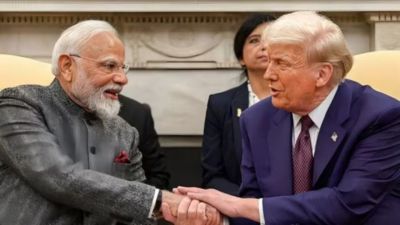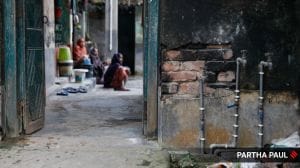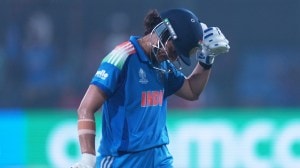Charity Fair
Kolkata has gone from being the Black Hole to Charity Bowl of India where Hollywood superstars Antonio Banderas and Penelope Cruz, popstar R...

Kolkata has gone from being the Black Hole to Charity Bowl of India where Hollywood superstars Antonio Banderas and Penelope Cruz, popstar Ricky Martin and celebrated author Dominique Lappierre, come for a quick-fix philanthropic massage, writes
A COUPLE of more visits and Ricky Martin may have a new name: Rickyda or Martinda. As Australian cricket star Steve Waugh or French writer Dominique Lapierre could tell the Peurto Rican popstar, that may well be the only Bengali he picks up from Kolkata, a city where both support charities.
| Steve Waugh is a major patron of Udayan, a home for children of leprosy patients. The organisation • Supports at least 300 children • Has 300 beds, mattresses, blankets • Hosted dinners to raise funds • Supports a 50-bed home for girl children of leprosy patients |
From Mother Teresa to Ricky Martin and Patrick Swayze to Penelope Cruz, Kolkata has had a long, intimate association with celeb charity. But until the recent visit of the Latino sensation, along with Spanish pop star Ignacio Cano, the association was mostly kept under wraps, despite the involvement and infrequent visits of Hollywood superstars like Antonio Banderas, Tom Cruise, Melanie Griffith and Esther Canadas.
This discretion is as indicative of the Kolkata bhadrolok’s ignore-it-if-it’s-unpleasant attitude towards celeb charity as it is of the international bleeding hearts’ surprising attraction for the eastern metropolis. Kolkata is certainly not the poorest place on earth, so what perpetuates its myth as the ultimate destination for the charity aristocracy?
‘‘Kolkata still seems to symbolise the worst kind of Third World poverty,’’ says Partha Chatterjee, the city’s resident sociologist. ‘‘It’s a problem of image.’’ It is an image shrewdly perpetuated by the city’s leading charity-dependent organisations. Consider what Sabera Foundation — it was responsible for Ricky Martin’s visit last week — says about Kolkata in its brochure: ‘‘Streets are teeming with children abandoned by their parents who are forced into begging and prostitution… (a city) where an estimated 50,000 female foetuses are killed every year following tests.’’ Though the latest Census report does indicate a drop in the male-female ratio, the Sabera figures would certainly astound local authorities.
| Ricky Martin, Penelope Cruz, Esther Canadas, Tom Cruise, Antoio Banderas, Melanie Griffith support the Sabera Foundation, which has: • 100-bed shelter for destitute girls •Two schools, two medical dispensaries •Three feeding support projects for 150 families. •Two cooperatives for designing and tailoring (this is patronised exclusively by Canadas) •Cruz will be hosting a gala dinner in New York City in October 2002 to raise $2 million for the Foundation |
Sabera is not alone in this. Check out the brochures of Udayan (meaning ‘resurrection’), a leprosy home first patronised by French missionary Rev James Stevens in the Seventies and later taken over by Lapierre and Waugh: ‘‘There are colonies of leprosy sufferers in the outskirts of major cities, dark and dingy. They live in appalling conditions in shame and rejection. They lead an unhappy and miserable life, till they die,’’ evoking images of misery of Biblical proportions. Few Koltatans would buy the claim that leprosy patients crowd the city.
The celeb association has a trickle-down effect as well: Foreign tourists, especially students from western countries, never fail to include a visit to Mother Teresa’s, Prem Dan, a shelter for abandoned children, while many cannot resist the temptation of visiting the ‘‘ slums of the city.’’
‘‘The city’s cultural background, its topography and logistics make for a winning combination for the NGO network. Though NGOs aren’t that many , their negotiating skills are immense,’’ acknowledges Raghab Bandopadhyay, the well-known essayist and writer. He is right, compared to the number of NGOs working in Orissa or Madhya Pradesh, or even in neighbouring Bangladesh, Kolkatta lags far behind. ‘‘Add to that the legacy of Mother Teresa and you have a winner,’’ he says with relish.
Internationally-renowned film director Mrinal Sen, who has seen both sides of the picture with his bold, stark films and through his association with Hollywood directors and stars like Ronald Joffe and Patrick Swayze, is gallant when he describes his home city. ‘‘Kolkata is a much-maligned but dangerously loved city. Foreign celebrities often describe their ‘shock at first sight’ while talking about Kolkata. But it is invariably replaced by deep love soon after.’’ In this context, he refers to his British journalist-friend James Cameron’s description of Kolkata: ‘‘I always find it (Kolkata) the most intimidating and infernal city. Every year I think, it won’t survive. But it always does.’’
It is this spirit of Kolkata which the international causeratti salutes, says Sandip Ray, son of legendary film director Satyajit Ray. ‘‘When it comes to Kolkata, some intrinsic magic moves celebrities, national and international,’’ says a mesmerised Ray.
Though overshadowed by their more starry counterparts, Indian celebs, too, have been involved with Kolkata charities. ‘‘We haven’t been lucky enough to garner international celebrities, but we have people like Aishwarya Rai, Mallika Sarabhai, Sourav Ganguly, Kapil Dev and Shobhaa De associated with our organisation,’’ says Subhra Chatterjee, head of communications at the Indian Institute of Cerebral Palsy. ‘‘In fact, Shobhaa De has pledged us the proceeds of her latest book, while Ganguly has promised to play in a benefit tie for us.’’
There is one difference between the national and international stars: The home-grown celebs often do not follow up on their commitments, while the international stars usually do. Take Ricky Martin, his flying visit to Kolkata had to be scheduled last week, sources say, because he would have been unable to give dates for the next five years!
| Dominique Lapierre • Donated over $50,000 to Mother Teresa • Contributes part of the royalties from his literary works to Udayan; also gifted a two-storied building and a school bus • Runs Sunderban Sopan, a medical charity in the Sunderbans • City of Joy Aid has dug at least 500 drinking water tubewells in slums in and around Kolkata |
‘‘Charity fits well into the agenda of celebrities,’’ says Chatterjee. ‘‘Most of them are associated one way or the other with some social cause and I don’t see this as a negative trend. In fact, a group of volunteers from Sweden told me recently, ‘Poverty is like pebbles, strewn all over the world. It’s just that in a massive country like India, the problems are more acute.’’
For Kolkata’s Steveda, however, it is Mrinal Sen’s inner-beauty theory that has lured him to the city. Waugh came on to the Kolkata charity scene a few weeks after Swedish tennis star Mats Wilander did but while Wilander’s enthusiasm proved to be a fleeting fancy, the Australian cricketer has built a lasting bond with the boys at Udayan, a home for the children of the leprosy-affected. So much so that when India plays Australia, the boys’ loyalties are severely tested: They support India, but back Steveda all the way.
Waugh reciprocates in kind: In 1999, when Australia won the World Cup, he sent a cake to the children, and later reportedly told his teammates that it was his good work at Udayan that won him the Cup. Waugh has inspired other Australian cricketers to visit the home and contribute to the cause; his brother Mark sponsors a couple of girls in Nivedita House, the new home for girl children of leprosy parents.
Waugh could well have inherited his legacy from Lapierre, who comes back to the city again and again. Lapierre, who initially worked with Mother Teresa, now has his own charity, called, The City of Joy Aid. From leprosy patients, Lapierre has now funded three boats to take basic medicare available to inaccessible regions in the Sunderbans. He has also pledged parts of the proceeds of his latest book, A Thousand Suns, to the charity he runs. Ask Lapierre why he chose Kolkata, and he will probably tell you it is his way of acknowledging ‘‘the strength of the human spirit’’ of the city. Something he has famously chronicled and funded.





- 01
- 02
- 03
- 04
- 05


























